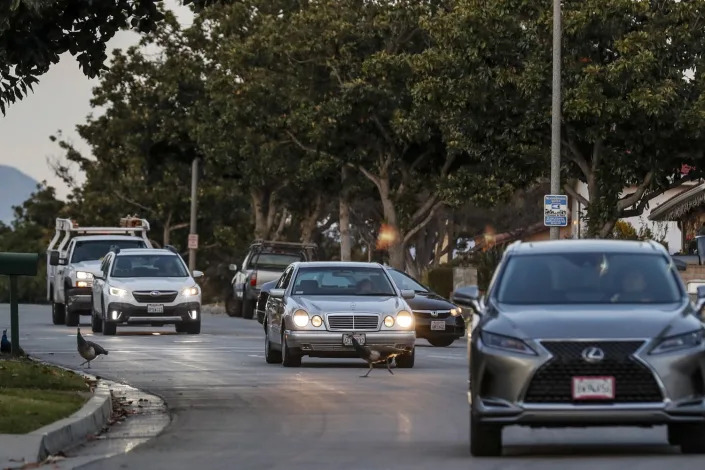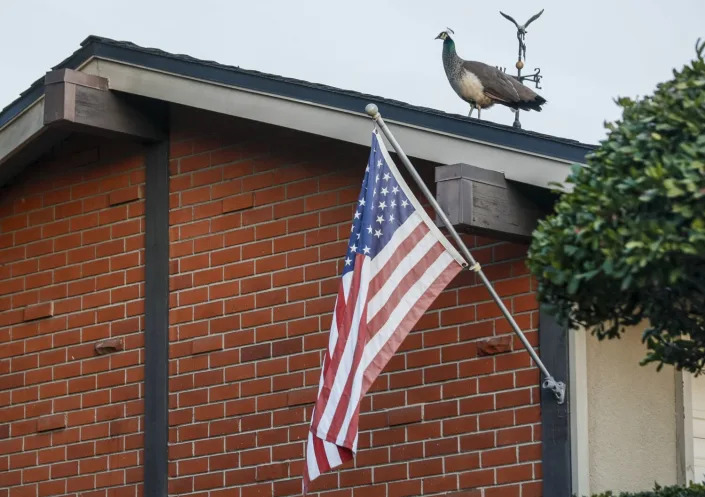They’re loud, they’re proud — these peacocks are getting the boot
If you live in Shadow Hills, peacocks are an everyday occurrence. They are as much a part of the landscape as the horses you’ll see walking up and down the streets. But why are some communities giving these beautiful birds the boot? In an article below posted in the LA Times, find out why the community of Monterey Hills in South Pasadena are not so fond of the turquoise beauties.
Shlomo Nitzani surveys his neighborhood for wild peafowl as some collect behind him. The removal of peafowl has been a pet project of Nitzani since 2010. (Robert Gauthier / Los Angeles Times)
About 45 minutes before dusk, 27-year-old Jonathan Gonzalez drove up the inclines of South Pasadena’s Monterey Hills community in a dark-blue pickup truck. He approached the house of a client and headed to the backyard.
There, Gonzalez inspected a 10-by-10 metallic cage he’d placed the previous week and eyed his catch: a bright blue, green and turquoise peacock — a squawking Fabergé egg with wings.
The bird was one of 47 peafowl he plucked, during a three-week span, from a neighborhood where the population numbers over 100.
The South Pasadena City Council, with the backing of aggrieved Monterey Hills residents, agreed to the entire population’s relocation from the city limits to private ranches and estates throughout California. The duty of capturing the birds was bestowed on one trapper: Gonzalez. His work, which began Dec. 2, was the culmination of several City Council meetings, one open forum, a petition drive and updates and opinions from citizens, bird experts and local law enforcement.
The story was first reported by the South Pasadena Review.
This hilly neighborhood is just the latest where Southern California’s battle over peafowl, the broader classification of peacocks (male), peahens (female) and peachicks (kids), is taking place.
Fights over their acceptance have erupted into illegal fowl shootings from the Palos Verdes Peninsula in 2014 to Ventura County on Halloween.
Less violent means of peacock population control have included Los Angeles County’s ban on feeding in unincorporated areas in 2021, which carries a fine of up to $1,000. San Marino and Pasadena have similar prohibitions. La Cañada Flintridge limits its population to nine peafowl and removes any additional birds.
Detractors point to feces-lined sidewalks, destroyed gardens, traffic jams, loud early-morning screeches compared to a howling infant and damage to vehicles and homes.
The peafowl removal, despite a six-month vetting process, has split South Pasadena.
“Peafowl walk along our block from time to time and I don’t ever see them causing any nuisance,” said Feliza Castellanos, a 41-year-old caterer who moved to South Pasadena two years ago. “They are beautiful birds; I don’t see why they want to round them up and get rid of them.”
A few blocks from Castellanos, 70-year-old Ron Reyes finished washing his home’s outdoor wheelchair ramp, hit with six peafowl feces spots, for the third time this week.
“There is just poop all over this ramp and I have to clean it so my son doesn’t track that crap into the house,” said Reyes, a retired landscaper. “This is infuriating, not to mention peacocks have destroyed my garden.”
Gonzalez, owner of Long Beach-based Raptor Events, keeps a low profile whenever he’s in town for a peafowl pickup.
“It’s never an easy choice but this is what South Pasadena wanted,” he said. “And this is the way I accomplish that, with low visibility and little notice to avoid attention of neighbors who do not approve of this process.”
Peafowl walk along Cam Linda Street across the street from the home of Shlomo Nitzani. This spring, Nitzani collected 250 signatures from residents living in the Altos de Monterey section of South Pasadena who were tired of peafowls and wanted them removed. (Robert Gauthier/Los Angeles Times)
After Gonzalez captures them, the birds are eventually resettled to private farms, ranches and open spaces in California that already have a bird population — usually chickens and other peafowl — and are at least 100 acres in size.
The estates and owner identities are kept confidential for safety reasons.
“A name was once given out and that person ended up getting harassed by local residents and others who don’t understand our work,” Gonzalez said.
Famed businessman and hotelier Elias J. “Lucky” Baldwin first imported the birds from India to his ranch in Arcadia, now known as the Arboretum, in the late 1870s, said Arboretum Chief Executive Richard Schulhof.
The park is the mecca for San Gabriel Valley peafowl and boasts a population of at least 100 birds. Schulhof said, however, that Baldwin was not the lone importer, and his researchers found other vendors, including publisher William Niles, who advertised the sale of peafowl dating back to 1885.
Fanny Johnson-Griffin, 86, a retired Los Angeles Unified principal and Monterey Hills resident since 1967, says peafowls have dropped down from the 50-foot pine tree near her garage in the “middle of the night” and startled her awake. She said they’ve eaten many of her hydrangea plants and she recently purchased a $50 tarp to cover her gazebo, which was “covered in poop.”
“They’re beautiful birds, but they belong in the zoo or in other towns around here, just not South Pasadena,” Johnson-Griffin said.
At the intersection of Flores De Oro and Via Del Rey, dubbed “Peacock Alley” by some residents, a flock of 30 peafowl — mothers, chicks and peacocks — crossed and remained in the middle of the street for minutes, which left drivers and bicyclists to brake, swerve and slow down on a recent afternoon. Gonzalez, who has removed peafowl from various Los Angeles County communities, including Altadena, said he’s never seen as dense a flock in as small an area.
Pasadena Humane conducted a three-day census in September that found that the peafowl population rocketed to 102, up from 36 the year before. Pasadena Humane Communications Manager Kevin McManus couldn’t offer a reason for their growth, but noted that the abundance of pine trees, where peacocks roost, and lack of predators made Monterey Hills attractive for peafowl.
Gonzalez believes the birds may have benefited from the pandemic shutdown. A lack of traffic on city streets provided the travelers “incentive to move” from peafowl-rich communities such as Arcadia and Pasadena into South Pasadena.
Feeding by residents, both contended, is also a path toward quick population growth.
Peafowl obstruct traffic on Via Del Rey near the home of Shlomo Nitzani. This spring, Nitzani collected 250 signatures from residents living in the Altos de Monterey section of South Pasadena who were tired of peafowls and wanted them gone. The City Council agreed to remove all birds within city limits. (Robert Gauthier/Los Angeles Times)
Whatever the reason for the birds’ explosion, 79-year-old Monterey Hills resident Shlomo Nitzani said their removal was necessary.
“The peafowls have to go,” he said. “There’s too many of them here and they’re not just destroying property, they’re damaging our lives.”
Nitzani moved to South Pasadena in 1976 and said he didn’t frequently see peafowl until 2010, when his wife Ellen occasionally fed them crackers.
Over the last two years, however, he’s grown tired of the near-daily summer 3 a.m. screeching serenades from peacocks right outside his bedroom window.
Nitzani’s black 2015 Toyota Camry is riddled with dents, talon marks and beak scratches, and the $30,000 he invested to landscape his front lawn is ruined by brown spots from lounging peafowl.
Walks for the former physical education instructor, who has had two knee replacement surgeries, included hobbling around dozens of white-and-black peafowl feces clumps in his walkway and along adjacent city streets.
During the spring, a fed-up Nitzani knocked on neighborhood doors with a petition calling on the City Council to oust the birds.
Nitzani said that most in the Monterey Hills community signed in favor of removal but that there were also a “few bleeding hearts.”
One such neighbor told The Times she was afraid to share her name for fear of retaliation from pro-removal hawks.
Nitzani collected more than 250 signatures, which were presented to the City Council at a July meeting during a public comment section that was overwhelmingly pro-relocation.
A month later, the City Council hosted an open forum split among backers of removal and detractors.
Monterey Hills resident Su Kim, 42, shared her frustration with the amount of peafowl feces in her backyard. The mother of three said her 2-year-old son ate a piece of guano a few years back while playing near the family swing set.
Kim, who moved from Silver Lake six years ago, told The Times she “wouldn’t have bought a home in South Pasadena had I been told about the peafowl situation.”
Monterey Hills Elementary School fourth-grader Estelle Mazza submitted a handwritten letter to express her support for the birds. “Seeing the peafowl and their babies makes me feel happy and ready for the day,” she wrote.
In a phone interview, the 10-year-old said she’ll see two or three peafowl on a typical walk to school and believes they make South Pasadena special.
“When I travel to different places like Texas and Wyoming, I don’t see peacocks,” she said. “They’re ours.”
Her principal, Laurie Narro, said there are around three to five peafowl on campus on any given school day. They prefer to hang out near the kindergarten playground, which has fewer children present, and in the lunch pavilion, where food may be lying around.
Narro said the increase in birds has custodians cleaning up more feces around campus. The peafowl are also “prolific jaywalkers” that cause “traffic jams” during the morning rush hour, said Narro, whose school considered changing its mascot from Roadrunners to Peacocks five years ago.
“I sympathize with those who see peafowl as a nuisance,” she said, “but I also empathize with our neighbors and children who would be saddened with their removal.”
Two months after the public forum, the fate of Monterey Hills’ peafowl was sealed.
On Oct. 5, South Pasadena adopted a Peafowl Management Plan that called for the removal of the birds, an annual census and review, along with the adoption of a no-feeding ordinance, which went into effect Nov. 16. Fines would range from $100 to $1,000 with possible imprisonment of up to six months.
South Pasadena Mayor Pro Tem Jon Primuth said the ordinance was as important as the peafowl removal.
A peafowl perches atop a house on Via Del Rey near the home of Shlomo Nitzani on Dec 14. (Robert Gauthier/Los Angeles Times)
“Residents are losing their patience with each other and those who continue to feed the wild peafowl,” Primuth said. “They think they’re doing a good deed, but what they’re actually doing is welcoming noise and feces and physical destruction.”
Where South Pasadena differs from other localities is its goal of eliminating rather than reducing the peafowl population, through “trapping and humane relocation.”
South Pasadena budgeted $25,500, or $250 per bird, for the process that continues through April.
Gonzalez, the trapper, has found volunteers from Monterey Hills willing to allow the placement of cages in their backyard. Inside each trap, peanut butter and corn are placed along with water to entice the peafowl. Once captured, the bird would be hauled away within 24 hours by Gonzalez.
On Dec. 20, Monterey Hills resident Craig Parks noticed a difference on his morning walk.
Normally the 53-year-old content executive spots multiple peafowl on rounds near his home. This time, however, he didn’t see one.
“I’m decidedly pro-peacock because outside of some traffic, they don’t cause much harm,” Parks said. “They, in fact, make South Pasadena special. I guess things are going to be a little more drab around here.”
This story originally appeared in Los Angeles Times.




